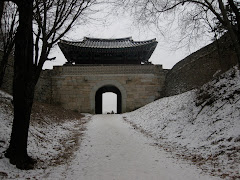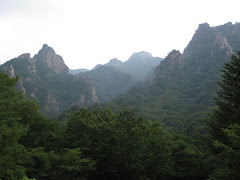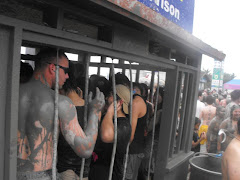Monday, September 28, 2009 at 10:20pm
Teaching continues to go well, though I miss the record high number of students experienced during the summer vacation months. Mostly, I miss some of the students I taught the past five months, and I wish they would return to school or I could pick and choose my students. One of my favorite classes is Happy Class, a discounted class offered late mornings on Monday/Wednesday for mostly housewives. We always have good discussion and they are a great class, though I sometimes think the students grow tired of the topics I select (usually cooking, cultural differences, my Korean travel plans, etc.) Kelly, Young, Cool, and Christine have each been in the class for several months now and we have an excellent relationship. In fact, sometimes we have lunch together immediately following class, coffee, or I prepare peanut butter and jelly sandwiches for the group. Kelly, Young, and Christine have also been instrumental in helping me adjust to Korean life and find my way around town. For this, I am incredibly grateful.
Another of my other favorite classes is Business English taught every Tuesday/Thursday evening. Good friend and favorite student B.H. has been a prominent fixture in this class from Day 1, and the number of students continues to grow each month. Currently, we are up to a record high 9 students enrolled this month in the class. Possibly some of my best lessons and class discussions have been here. Maybe it's just because I'm a Business major or have a profound interest in the subject, but some of our discussions have included: the competitive advantage of Starbucks in Korea, analysis of Hyundai Kia Automotive Group and their recent success, use of technology and innovation in our daily lives and how to apply this to our professions, economical issues, etc. Actually, if enrollment continues to increase, I hope to convince the school to open a second Business English class offered in the morning.
I have but a few complaints with teaching, and they are all minor. First of all, some Koreans do not stay home when they are sick. Instead, they come to class sneezing and coughing for others to see and be exposed to. It's a bit annoying, especially when many here blame the foreigners for exposure to swine flu. I have made it a practice to keep hand sanitizer in class and make sure to wash thoroughly after touching items in the classroom, after every class, just to be safe.
Another complaint are the few students who attend class once or twice a month, and usually do not have much to contribute when they do attend. It's silly for me to complain about this as it's their money they're wasting, but I truly do care about the students and the quality of the education I offer them. Another complaint along this line is one particular class I am teaching this month where the students do not like to speak or have difficulty becoming active in the class discussion. After four weeks, I am so frustrated with the class, I have told the school I cannot teach them after this month. It's incredibly aggravating, and James, who taught this class last month, had the same frustration with them. I guess I should be fortunate that, after five months, this is the only class I have experienced this difficulty with.
Aside from these minor complaints, and really, they all seem trivial, I can honestly say I love teaching and I'm delighted with my decision to be here. Teaching is something I never thought I would do in my adult life, let alone be any good at, and it's surprising where life can lead you. This experience, I think, so many friends of mine would not only enjoy, but surprisingly, be very good at. One of the best parts about my job, aside from the friendships I have forged with many students, is the laughter we often share together in class. It's these jovial and outgoing individuals who make my teaching experience worthwhile.
I have begun to get this same satisfaction from my experience reading children's books at the library on a weekly basis. Once again, this is something I never thought I would enjoy, let alone be successful with. Each week, there are usually between 20-40 children, perhaps 5-8 years average age, with another 10-20 parents in attendance. I recognize many of the same faces each week, and on most days I am lucky enough to get a big smile or sometimes even a hug from them. Some of the children have also brought me presents. Others remain skeptical around me and prefer their comfort of their parent's arms. Not to sound incredibly lame, but I find this to be a very rewarding experience and it makes me feel good to give something back.
An interesting observation is just how incredibly well young Korean schoolchildren can speak English, and often, with little or no accent at all. Usually, the older students speak with some form of an accent, even a slight English or Australian accent depending upon if they may have studied or lived abroad. The reason for the difference is because the older students did not begin their studies until a later age, perhaps middle school, and this difference is largely noticeable.
English education at a pre-school or kindergarten age remains a controversial subject here in Korea. In fact, this topic has been the source of many discussions in class. It truly is unbelievable the importance and emphasis on English skills in this country, as it seems to be a pre-requisite for college entrance and employment. In other words, one's English ability determines their place in society, and it beckons the question if the Korean language will someday disappear or simply fade away.
The positive side, of course, is the high demand this creates for native English teachers, such as myself. Korean institutions and public schools pay attractive salaries, provide good benefits and usually free housing for foreign teachers. ESL teaching really is a remarkable way to experience life outside North America and learn about a foreign country, it's people, their history and language.
Here's another observation. Students in my Saturday a.m. class and were discussing American holidays and the subject of parades came up. Korea, apparently, rarely has parades, which is disappointing. I was told they used to have a parade every year for Soldiers Day, first week of November, though this practice has ended within the past ten years or so. When asking my students why there no longer is a parade on Soldiers Day, I was told because the tanks destroyed the roads. Apparently, Soldiers Day in Korea used to present to the public a massive march of thousands of soldiers accompanied by a an arsenal, literally, of military equipment, missiles, tanks, etc. Wow!
The approaching weekend, October 1-4 is Korean Thanksgiving, Chuseok, and it's a four day holiday from my school. I have learned Chuseok is, perhaps, one of the most important Korean holidays and, similar to the U.S., is a time for families to gather and celebrate the good things in life. Small gifts are often shared with others, delicious foods are prepared, and many, many people travel, thus making it difficult to go anywhere. Despite the logistical difficulties, I have managed to secure KoRail passage to Pusan, where I will visit with Toledo friends Greg and Brian, and Greg's girlfriend, Suji. Another fun weekend, I am sure, will be had by all.
Best wishes!
























































































































































